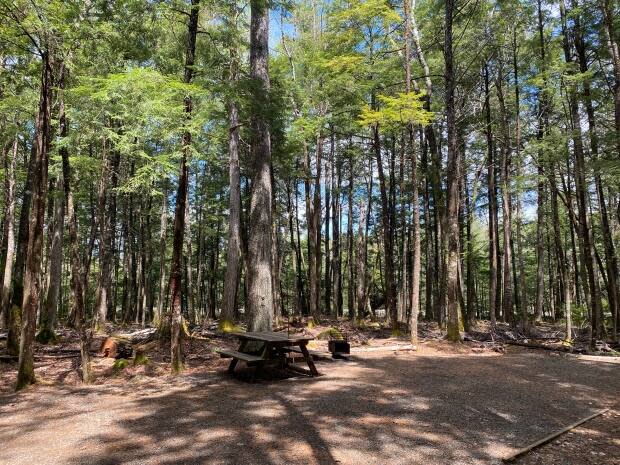Visiting Keji this summer? Make sure you don't take home these tiny, destructive bugs

When staff at Kejimkujik National Park and Historic Site welcome visitors this year, they'll also ask them to be extra careful not to accidentally bring home a tiny, destructive pest.
It's one way the park is trying to limit the spread of the hemlock wooly adelgid, an invasive insect native to Japan that's threatening some of southwest Nova Scotia's oldest forests.
"If they get onto a bird or a person's coat, they can travel long distances like that and survive," Dave Ireland, a project manager at Kejimkujik, told CBC Radio's Maritime Noon. "What we're hoping is that people recognize ... they may inadvertently grab some of these crawlers on their clothes or their trailers."
Ireland is urging campers and visitors to Keji to wash their clothes and wipe down their gear when they leave, especially if they plan to explore hemlock stands in other parts of the province. He said using a lint roller on your clothes often does the trick.

Right now, the tiny bug is largely contained to southwest Nova Scotia, but Ireland fears it's only a matter of time before they end up infecting trees in Halifax. They only hurt eastern hemlock trees, not people or animals, said Ireland.
"We need to get the word out that this critter is one the move, and people can help," he said.
Listen to Maritime Noon's interview at Kejimkujik National Park and Historic Site:
Injecting trees with insecticide
Park staff have also begun injecting some of Keji's hemlocks with a product called IMA-jet that kills wooly adelgid.
Ireland said the decision to use a pesticide on the trees comes after a lengthy environmental impact assessment in consultation with Mi'kmaw communities.

"That little tiny bug, which is a big problem here for Kejimkujik, really starves the trees of nutrients and it sucks the nutrients and the sap out of the trees," said park ecologist Matthew Smith, who has been working on the hemlock wooly adelgid project since 2017.
He said because the insects, which were first detected in the park in 2018, create a wooly case around themselves, it's difficult to spray them from the outside.
Instead, park staff are drilling about three-inch holes into a select number of trees and injecting the insecticide using a special instrument that looks like a glue gun. This ensures "the vascular system takes up the pesticide."
"If they weren't treated, we expect trees like this would die, certainly within two, three years because some of them are already been infested for a while," Smith said.
The treatment is supposed to protect the trees for about five to seven years. Parks Canada has said trees injected with the product would be permanently marked and monitored, and that repeat treatments would likely be needed in the future.

The plan is to treat about five or six "commemorative" stands of Keji's hemlock so they are around for future generations, Ireland said.
A number of locations at the park have been chosen, including at Jeremy's Bay campground and Hemlocks and Hardwoods Trail.
"But let's be honest, there is going to be a mortality event and we are going to see a lot of hemlocks die and we're coming to terms with that," Ireland said.
He urged people to report sightings of the insect to the Canadian Food and Inspection Agency or by emailing hwa@nshemlock.ca so scientists can monitor where the tiny critters go next.

MORE TOP STORIES

 Yahoo Movies
Yahoo Movies 
